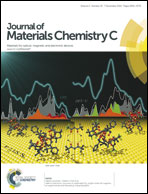Investigation on preparation and electric field tunable dielectric properties of novel bismuth magnesium niobate transparent capacitors for opto-electronic devices
Abstract
Transparent capacitors, based on bismuth magnesium niobate (Bi1.5MgNb1.5O7, BMN), have been fabricated on indium tin oxide glass substrates by rf magnetron sputtering. The effect of post-annealing conditions on structural, electrical, and optical properties of BMN thin films was investigated. X-ray diffraction patterns and scanning electron microscopy reveal that the BMN thin films post-annealed at an oxygen partial pressure of 0.1 MPa have the best crystalline quality compared to BMN films post-annealed under all other conditions. The BMN thin films exhibit an average transmittance of 85% in the visible light range (380–780 nm), while the value of optical absorption edge is 3.59 eV. Dielectric measurements indicate that the thin films exhibit a medium dielectric constant of about 99, a low loss tangent of 0.0037, and superior tunable dielectric properties at room temperature. Calculations of dielectric tunability and the figure of merit (FOM) display a maximum value of 28% at 1.3 MV cm−1 and ∼57, respectively. The results show that BMN thin films have great potential for use in electric field tunable transparent capacitors.


 Please wait while we load your content...
Please wait while we load your content...